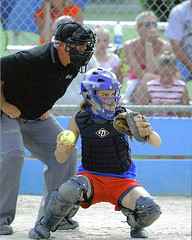The thumb is an important part of performing the skills of fastpitch softball. There have been exceptions to this rule (when the non-throwing thumb is injured) but by and large to perform at a productive level, we need eight fingers and two thumbs.

One of the most common injuries for catchers is called “catcher’s thumb.” The injury involves the ligaments surrounding the thumb and affects the ability to catch and hit. Anyone who has ever caught a pitch on the thumb, at an awkward angle, knows exactly what is being described. The thumb feels like you were told to make a fist with your fingers (thumb out), point your thumb up in the air as you rest the pinky side of your hand on a table and then have a 100-pound weight dropped directly on the tip of the thumb! Wow! After the initial pain wears off, and the swelling from this “super-sprain” goes away (if it ever does completely), you cannot open a can of juice, turn a door knob, tie your shoes, pull up a zipper, etc.
What has been causing the rash of thumb injuries the past eight years in fastpitch and how can we prevent it? After talking with many scholars and coaches of the game, I have come up with a few thoughts on the causes of this injury:
1) Better teaching of the pitchers to be able to throw the hard drop down and in with greater velocity and movement.
2) A lack of teaching of the catching position. Young catchers are not made aware of the proper techniques involved in Fastpitch catching compared to baseball:
3) The difference in the balls, going from a wide use of the softer ball (SB-12) to a harder ball (exp. – Thunder) in the past eight years.
4) The wider use of the Fastpitch catching glove instead of the first base-baseman’s glove which has more web.
Examples 1 and 3 have validity and can be argued to make sense but they are opinions. Examples 2 and 4 are opinions also: however, I have a tendency to agree with them more and will try to explain the widespread dreaded “catcher’s thumb.”
We do know that not enough time is spent with the young catchers albeit for catching clinics that coincide with pitching clinics. One of the biggest crimes in theme type of clinics is that the catchers act as backstops for the pitchers. There is no benefit to this practice if it occurs more than 30 minutes per day. The catchers need to be taught more applicable theory and when to use it in hypothetical situations: What will the rise do? What will the drop do? How does a leftie’s ball differ from a rightie’s etc…..
Fastpitch catching is totally different than baseball catching in respect to the ball. That is the main reason why I am about to give you reasons why a first-base glove is most beneficial to the fastpitch catcher.
If a young fastpitch catcher is brought up with a softball “catchers” glove, he/she will be more likely to try and catch the ball in the lowest part of the web and the palm. Once the game moves to the big ball, the sphere is larger and the movement is greater due to physics (air flow over a greater area with seams) With the percentage of web space being greatly outnumbered by the percentage of pocket area, we can almost guess where the ball is going to be caught. Now add in movement, and the catcher’s hand (thumb included) will take the brunt of the pitch. The fingers naturally will be fine because they face away from the palm, but if you hold your thumb up in a relaxed position, the outside of it will face the pitcher and if a direct hit is taken, the ligaments will strain and sprain back. With this backward sprain comes pain in the knuckle of the base of the thumb. So what can be done?
Well, we can wrap the thumb prior to catching but that would be illogical because the hand must be as maneuverable as possible. I believe that the catchers must get back to the “act” of “webbing” the pitch and while looking it into the web.
The first-base mitt is ideal for Fastpitch catchers. It is light and maneuverable, which is so key for the catcher when the ball is moving up or down (in or out) just three feet in front of home plate. The extended mitt makes it easier for catchers to react to rise balls, drops, and curves that are breaking away from the strike zone. The worst crime we see nowadays is the rise that tips the “catchers” mitts and goes as a wild pitch. We don’t see this so much with the first-base glove.
By utilizing the first-base glove and catching the ball more in the web, the thumb is not directly in the immediate impact area. If there is one reason to switch, this is it. The first-base glove will do more of the catching of the ball than the hand.
Granted, this article is written on observation, opinion, and personal experience. However, when Michelle Granger and Michele Smith throw to me, I want the web and not my hand to stop the ball. They have a tendency to throw it hard. When young catchers (or inexperienced catchers) first get behind the plate, they have a impact (exp. Of the 100 pound weight). With the first-base mitt, we can wait a longer time for the ball to come to the catcher’s glove area. Because of the length of a first-base mitt, there is more time to react “away” from the immediate pocket, thus giving the catcher a better chance to avoid thumb injuries.